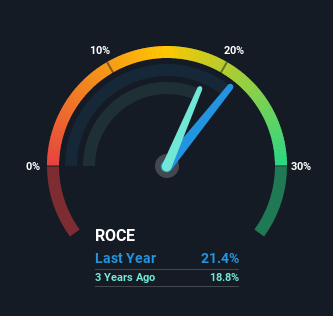Returns on Capital Paint A Bright Future For Kaveri Seed (NSE:KSCL)

If we want to find a stock that could multiply over the long term, what are the underlying trends we should look for? Ideally, a business will show two trends; firstly a growing return on capital employed (ROCE) and secondly, an increasing amount of capital employed. This shows us that it's a compounding machine, able to continually reinvest its earnings back into the business and generate higher returns. Speaking of which, we noticed some great changes in Kaveri Seed's (NSE:KSCL) returns on capital, so let's have a look.
What is Return On Capital Employed (ROCE)?
Just to clarify if you're unsure, ROCE is a metric for evaluating how much pre-tax income (in percentage terms) a company earns on the capital invested in its business. Analysts use this formula to calculate it for Kaveri Seed:
Return on Capital Employed = Earnings Before Interest and Tax (EBIT) ÷ (Total Assets - Current Liabilities)
0.21 = ₹2.8b ÷ (₹20b - ₹6.8b) (Based on the trailing twelve months to March 2021).
So, Kaveri Seed has an ROCE of 21%. In absolute terms that's a great return and it's even better than the Food industry average of 12%.
View our latest analysis for Kaveri Seed

Above you can see how the current ROCE for Kaveri Seed compares to its prior returns on capital, but there's only so much you can tell from the past. If you're interested, you can view the analysts predictions in our free report on analyst forecasts for the company.
So How Is Kaveri Seed's ROCE Trending?
The trends we've noticed at Kaveri Seed are quite reassuring. Over the last five years, returns on capital employed have risen substantially to 21%. The amount of capital employed has increased too, by 37%. The increasing returns on a growing amount of capital is common amongst multi-baggers and that's why we're impressed.
The Bottom Line On Kaveri Seed's ROCE
In summary, it's great to see that Kaveri Seed can compound returns by consistently reinvesting capital at increasing rates of return, because these are some of the key ingredients of those highly sought after multi-baggers. And with a respectable 59% awarded to those who held the stock over the last five years, you could argue that these developments are starting to get the attention they deserve. In light of that, we think it's worth looking further into this stock because if Kaveri Seed can keep these trends up, it could have a bright future ahead.
If you want to continue researching Kaveri Seed, you might be interested to know about the 2 warning signs that our analysis has discovered.
High returns are a key ingredient to strong performance, so check out our free list ofstocks earning high returns on equity with solid balance sheets.
If you decide to trade Kaveri Seed, use the lowest-cost* platform that is rated #1 Overall by Barron’s, Interactive Brokers. Trade stocks, options, futures, forex, bonds and funds on 135 markets, all from a single integrated account. Promoted
Valuation is complex, but we're here to simplify it.
Discover if Kaveri Seed might be undervalued or overvalued with our detailed analysis, featuring fair value estimates, potential risks, dividends, insider trades, and its financial condition.
Access Free AnalysisThis article by Simply Wall St is general in nature. It does not constitute a recommendation to buy or sell any stock, and does not take account of your objectives, or your financial situation. We aim to bring you long-term focused analysis driven by fundamental data. Note that our analysis may not factor in the latest price-sensitive company announcements or qualitative material. Simply Wall St has no position in any stocks mentioned.
*Interactive Brokers Rated Lowest Cost Broker by StockBrokers.com Annual Online Review 2020
Have feedback on this article? Concerned about the content? Get in touch with us directly. Alternatively, email editorial-team (at) simplywallst.com.
About NSEI:KSCL
Kaveri Seed
Researches, develops, produces, processes, and markets hybrid seeds and vegetable crop seeds in India.
Flawless balance sheet average dividend payer.
Market Insights
Community Narratives



